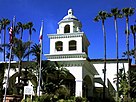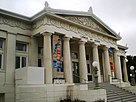
A | B | C | D | E | F | G | H | CH | I | J | K | L | M | N | O | P | Q | R | S | T | U | V | W | X | Y | Z | 0 | 1 | 2 | 3 | 4 | 5 | 6 | 7 | 8 | 9
Oxnard, California | |
|---|---|
|
Clockwise: Channel Islands Harbor; Carnegie Art Museum; hotel at the beach | |
| Nickname(s): Gateway to the Channel Islands, The Nard[1] | |
 Location in Ventura County and the state of California | |
| Coordinates: 34°11′29″N 119°10′57″W / 34.19139°N 119.18250°W | |
| Country | United States |
| State | California |
| County | Ventura |
| Region | Oxnard Plain |
| Incorporated | June 30, 1903[2] |
| Named for | Henry T. Oxnard |
| Government | |
| • Type | Council–manager |
| • Mayor | John Zaragoza |
| • City council[4] |
|
| • City treasurer | Phil Molina |
| • City clerk | Rose Chaparro[3] |
| • City manager | Alexander Nguyen |
| Area | |
| • City | 39.14 sq mi (101.38 km2) |
| • Land | 26.53 sq mi (68.70 km2) |
| • Water | 12.62 sq mi (32.68 km2) 31.41% |
| Elevation | 52 ft (16 m) |
| Population | |
| • City | 202,063 |
| • Rank | 1st in Ventura County 22nd in California 117th in the United States |
| • Density | 7,616.40/sq mi (2,940.71/km2) |
| • Urban | 376,117 (US: 109th) |
| • Urban density | 4,909.7/sq mi (1,895.6/km2) |
| • Metro | 843,843 (US: 71st) |
| Time zone | UTC−8 (Pacific) |
| • Summer (DST) | UTC−7 (PDT) |
| ZIP Codes[8] | 93030–93036 |
| Area codes | 805 and 820 |
| FIPS code | 06-54652 |
| GNIS feature IDs | 1652766, 2411347 |
| Website | www |
Oxnard (/ˈɒksnɑːrd/ ⓘ) is a city in Ventura County in the U.S. state of California, United States. On California's South Coast, it is the most populous city in Ventura County and the 22nd-most-populous city in California. Incorporated in 1903, Oxnard lies approximately 60 miles (97 km) west of downtown Los Angeles and is part of the larger Greater Los Angeles area.
It is at the western edge of the fertile Oxnard Plain, adjacent to agricultural fields with strawberries, lima beans and other vegetable crops. Oxnard is also a major transportation hub in Southern California, with Amtrak, Union Pacific, Metrolink, Greyhound, and Intercalifornias stopping there. It also has a small regional airport, Oxnard Airport (OXR). The town also has significant connections to the nearby oil fields Oxnard Oil Field and the West Montalvo Oil Field. The high density of oil, industry and agricultural activities around the city, have led to several environmental issues.[9]
Oxnard's population was 202,063 in 2020,[10] and is largely Latino.[9] It is the most populous city in the Oxnard–Thousand Oaks–Ventura, CA Metropolitan Statistical Area.
History
This section needs additional citations for verification. (November 2022) |


Before the arrival of Europeans, the area was inhabited by Chumash Native Americans. The first European to encounter the area was explorer João Rodrigues Cabrilho, who claimed it for Spain in 1542. During the mission period, Mission San Buenaventura, established in 1782, used the area for raising cattle.
Ranching began to take hold among Californio settlers, who lost their regional influence when California became a US state in 1850. At about the same time, the area was settled by American farmers, who cultivated barley and lima beans.
The Gottfried Maulhardt/Albert Pfeiler Farm site is now an historic farm park.[11]
Henry T. Oxnard, founder of Moorhead, Minnesota-based American Crystal Sugar Company who operated a successful sugar beet factory with his three brothers (Benjamin, James, and Robert) in Chino, California, was enticed to build a $2 million factory on the plain inland from Port Hueneme.[12] Shortly after the 1897 beet campaign, a new town emerged, now commemorated on the National Register of Historic Places as the Henry T. Oxnard Historic District. Oxnard intended to name the settlement after the Greek word for "sugar", zachari, but frustrated by bureaucracy, named it after himself. Given the potential growth of the town of Oxnard, in the spring of 1898, a railroad station was built to service the plant, which attracted a population of Chinese, Japanese, and Mexican laborers and enough commerce to merit the designation of a town. The Oxnard brothers, who never lived in their namesake city, sold both the Chino and the giant red-brick Oxnard factory in 1899 for nearly $4 million. The Oxnard factory with its landmark twin smokestacks operated from August 19, 1899, until October 26, 1959. Factory operations were interrupted in the Oxnard Strike of 1903.

Oxnard was incorporated as a California city on June 30, 1903, and the public library was opened in 1907.[13] Prior to and during World War II, the naval bases of Point Mugu and Port Hueneme were established in the area to take advantage of the only major navigable port on California's coast between the Port of Los Angeles and San Francisco Bay, and the bases in turn encouraged the development of the defense-based aerospace and communications industries.
In the mid-20th century Oxnard grew and developed the areas outside the downtown with homes, industry, retail, and a new harbor named Channel Islands Harbor. Martin V. ("Bud") Smith (1916–2001) became an influential developer. Smith's first enterprise in 1941 was the Colonial House Restaurant (demolished 1988) and then the Wagon Wheel Junction in 1947, (demolished 2011).[14] He was also involved in the development of the high-rise towers at the Topa Financial Plaza,[15] the Channel Islands Harbor, Casa Sirena Resort, the Esplanade Shopping Mall,[16] Fisherman's Wharf, the Carriage Square Shopping Center, the Maritime Museum, and many other hotel, restaurant and retail projects.[17][18]
In June 2004, the Oxnard Police Department and the Ventura County Sheriff imposed a gang injunction over a 6.6-square-mile (17 km2) area of the central district of the city, in order to restrict gang activity.[19] The injunction was upheld in the Ventura County Superior Court and made a permanent law in 2005.[20] A similar injunction was imposed in September 2006 over a 4.26-square-mile (11.0 km2) area of the south side of the city.[21] Prohibited activities include associating with other known gang members, witness intimidation, possessing firearms or using gang gestures.[22] Since then, court decisions have made adding people to the civil orders more stringent, stemming from lawsuits in Los Angeles and Orange counties. Judges determined that it was unconstitutional for people to be added to a gang injunction without a due-process hearing. As a result of budget cuts due to the COVID-19 pandemic, the Oxnard police stopped maintaining and enforcing the injunction in 2020.[23]
Geography
Oxnard is located on the Oxnard Plain, an area with fertile soil. With its beaches, dunes, wetlands, creeks and the Santa Clara River, the area contains a number of important biological communities. Native plant communities include: coastal sage scrub, California Annual Grassland, and Coastal Dune Scrub species; however, most native plants have been eliminated from within the city limits to make way for agriculture and urban and industrial development. Also native to the region is the endangered Ventura Marsh Milkvetch, and the last self-sustaining population is in Oxnard in the center of an approved housing development.[24]
Rivers
The Santa Clara River separates Oxnard and Ventura. Tributaries to this river include Sespe Creek, Piru Creek, and Castaic Creek.
Geology
Oxnard is on a tectonically active plate, since most of Coastal California is near the boundaries between the Pacific and North American Plates. The San Andreas Fault, which demarcates this boundary, is about 40 miles away.
One active fault that transverses Oxnard is the Oak Ridge Fault, which straddles the Santa Clara River Valley westward from the Santa Susana Mountains, crosses the Oxnard Plain through Oxnard, and extends into the Santa Barbara Channel. The coastline is subject to inundation by a tsunami up to 23 feet in height.[25]
The fault has proven to be a significant contributor to seismic activity in the Oxnard region and beyond. The 6.7 Mw Northridge earthquake that occurred on January 17, 1994, is believed to have occurred in the Santa Clarita extension of the Oak Ridge Fault. Landslides and ridge-top shattering resulting from the Northridge earthquake were observed above Moorpark, a city 19.6 mi (31.5 km)[26] east of Oxnard.[27]
Climate
Oxnard is the location of the National Weather Service forecast office that serves the Los Angeles area.[28] The city is situated in a Mediterranean (dry subtropical) climate zone, experiencing mild and relatively wet winters, and warm, dry summers, in a climate called the warm-summer Mediterranean climate. Onshore breezes keep the communities of Oxnard cooler in summer and warmer in winter than those further inland. The average mean temperature is 61 °F (16 °C). The average minimum temperature is 52 °F (11 °C) and the average maximum temperature is 69 °F (21 °C). Generally the weather is mild and dry, with around 300 days of sunshine annually. The average annual precipitation is 15.62 in (397 mm).[29]
| Climate data for Oxnard, California (Oxnard Airport), 1991–2020 normals, extremes 1923–present | |||||||||||||
|---|---|---|---|---|---|---|---|---|---|---|---|---|---|
| Month | Jan | Feb | Mar | Apr | May | Jun | Jul | Aug | Sep | Oct | Nov | Dec | Year |
| Record high °F (°C) | 94 (34) |
91 (33) |
94 (34) |
100 (38) |
98 (37) |
102 (39) |
96 (36) |
97 (36) |
105 (41) |
104 (40) |
98 (37) |
96 (36) |
105 (41) |
| Mean maximum °F (°C) | 81.7 (27.6) |
80.8 (27.1) |
82.7 (28.2) |
85.3 (29.6) |
80.6 (27.0) |
80.3 (26.8) |
83.0 (28.3) |
84.1 (28.9) |
87.6 (30.9) |
92.3 (33.5) |
86.6 (30.3) |
79.6 (26.4) |
94.8 (34.9) |
| Mean daily maximum °F (°C) | 65.9 (18.8) |
65.4 (18.6) |
65.6 (18.7) |
66.6 (19.2) |
68.0 (20.0) |
69.5 (20.8) |
72.9 (22.7) |
73.5 (23.1) |
73.5 (23.1) |
73.5 (23.1) |
70.0 (21.1) |
65.9 (18.8) |
69.2 (20.7) |
| Daily mean °F (°C) | 56.0 (13.3) |
56.6 (13.7) |
57.4 (14.1) |
58.5 (14.7) |
61.2 (16.2) |
63.7 (17.6) |
66.7 (19.3) |
67.1 (19.5) |
66.6 (19.2) |
64.5 (18.1) |
60.1 (15.6) |
56.4 (13.6) |
61.2 (16.2) |
| Mean daily minimum °F (°C) | 46.1 (7.8) |
47.7 (8.7) |
49.3 (9.6) |
50.5 (10.3) |
54.3 (12.4) |
57.9 (14.4) |
60.6 (15.9) |
60.6 (15.9) |
59.7 (15.4) |
55.4 (13.0) |
50.1 (10.1) |
46.9 (8.3) |
53.3 (11.8) |
| Mean minimum °F (°C) | 37.8 (3.2) |
38.4 (3.6) |
40.4 (4.7) |
43.1 (6.2) |
47.4 (8.6) |
50.8 (10.4) |
54.5 (12.5) |
54.5 (12.5) |
52.6 (11.4) |
47.7 (8.7) |
41.6 (5.3) |
37.4 (3.0) |
35.8 (2.1) |
| Record low °F (°C) | 26 (−3) |
28 (−2) |
31 (−1) |
31 (−1) |
34 (1) |
37 (3) |
42 (6) |
43 (6) |
40 (4) |
35 (2) |
28 (−2) |
28 (−2) |
26 (−3) |
| Average precipitation inches (mm) | 2.92 (74) |
3.26 (83) |
2.30 (58) |
0.69 (18) |
0.34 (8.6) |
0.06 (1.5) |
0.02 (0.51) |
0.01 (0.25) |
0.08 (2.0) |
0.46 (12) |
0.71 (18) |
2.08 (53) |
12.93 (328.86) |
| Average precipitation days (≥ 0.01 in) | Zdroj:https://en.wikipedia.org?pojem=Oxnard,_California|||||||||||||





